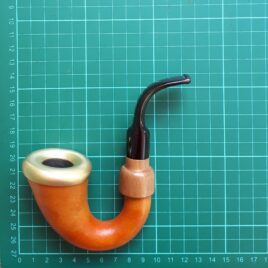Description
The Calabash pipe
Made from the neck of a gourd that has been deliberately shaped during its growth, the Calabash offers a different experience in smoking. Being extremely porous, the Calabash is virtually self-cleaning in that any moisture absorbed from the smoke passes through the pipe and evaporates, colouring the pipe to a rich brown. Being a natural product, grown in the open air, it is subject to the vicissitudes of nature – which means it will usually have small surface marks from the action of weather or insects. Once the pipe has been well coloured these marks look like “beauty spots” on the rich brown surface.
Read more on http://www.wesleys.co.za/archives4.htm#archivecala
The pipes are individuals – each one is different; the shape depends on the bend of the original gourd.
The farm outside Calitzdorp is no longer supplying calabash gourds for pipes, but I’ve been told that further north in Africa production has started.
Read even more on https://www.smokingpipes.com/smokingpipesblog/single.cfm/post/origins-the-calabash-pipe
Turkish Meerschaums.
The best quality Meerschaum blocks (or stones) of hydrous magnesium silicate, to use the correct geological name, are mined in Turkey. The mines are concentrated in a small area near the town of Eskisehir, and can be as deep as 450 feet (130 odd metres) where working conditions are not for the faint-hearted. The stones are split into smaller pieces similar to briar ebauchons – in fact the process is similar to cutting diamonds if you think of the skill necessary to use the natural fault lines and of the value of the raw material – and thereafter cleaned and sorted into varying grades and qualities depending on the size, density, colour and uniformity of the block. The bowl is then carved or turned, the amber-coloured lucite* mouthpiece is fitted, the pipe is given a final polish and the bowl is dipped in molten bees-wax. The waxing determines how well the meerschaum will colour. The last 2 shipments we received were a little more golden than previous shipments – the pipes had received additional waxing to improve the colour when the pipes are smoked.
At an early stage certain of the blocks are ear-marked for the stunning carved heads by master craftsmen who often specialise. Our larger Bacchus heads are some of the last from a current master carver about to retire – but no doubt there is a young aspirant Michelangelo waiting his chance in the wings.
Smooth, classic shapes are turned on a lathe and finished by hand. The polishing can take quite a long time as too much pressure will ruin the finish. Creative etching covers odd surface marks.
*(Before synthetics, amber was the material of choice for the mouthpiece; but Lucite is less brittle, easier on the teeth and more readily available than amber. The Lucite mouthpiece has a Teflon peg, and a matching Teflon sleeve which is screwed into the meerschaum shank. Removing and replacing the mouthpiece is just a simple pull or push. If you need to rotate the mouthpiece, do so only in a clockwise direction so you won’t unscrew the sleeve.)
The incentive to mine meerschaum is not only that it is the perfect material from which to make smoking pipes. The meerschaum industry including pipes, filters, trinkets and even its use in insecticides, automobile paint and porcelain, contributes to exports worth a couple of million dollars (US) a year.
(Visit https://www.allaboutturkey.com/luletasi.html)





